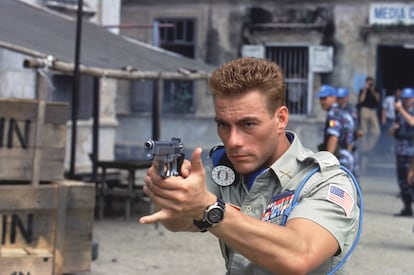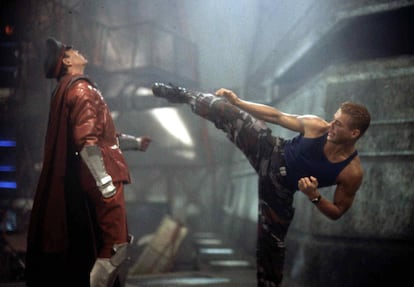‘What went wrong? Everything!’: 30 years of ‘Street Fighter,’ which almost went off the rails due to Van Damme’s erratic behavior
Despite being panned by critics, the video game adaptation was a commercial success, and its very eccentricities keep it alive to this day

With Sonic the Hedgehog 3 besting all competition at the box office — including Disney’s Christmas blockbuster Mufasa: The Lion King, no less — it’s boom times for the never-very-well-received video game-based film. Last year, The Super Mario Bros. Movie became the biggest commercial success in the history of such adaptations, while Five Nights at Freddy’s, based on the independent series of the same name, turned into another phenomenon. Granted, none were greeted with much enthusiasm from critics, besides the acclaimed The Last of Us. The explanation for their financial success may come down to demographics and a public made up of dedicated players that impacts the way these cinematic versions are articulated in the era of fan service. We have seen a character’s design changed at the last minute to please fans, as happened with the first Sonic (2020), as well as a game’s aesthetic wielded as an end in itself, even when a film’s narrative suffers from an overreliance on references to the original product.
But for these projects to run, others had to walk. Three decades before the record-setting Super Mario Bros. Movie, the first U.S. conversion of a video game to a live-action feature film was 1993′s Super Mario Bros., which reaped a poor financial showing with its eccentric proposal. The movie scattered elements of the game throughout a wild science fiction narrative capable of absorbing evolved dinosaurs, parallel dimensions, vanished parents, mushrooms and Dennis Hopper. But when it comes to bonkers adaptations, the one that has established itself as the decade’s standard bearer is Street Fighter, which hit theaters in the United States on December 25, 1994. The film continues to draw interest thanks to its campy appearance, grandiloquent dialogue, overacting and juicy anecdotes that continue to emerge from a turbulent shoot that, amid clashes of ego and production challenges, became a perfect storm.
“What went wrong? Everything,” Steve Hendershot, global authority on the franchise and author of the book Undisputed Street Fighter: The Art and Innovation Behind the Game-Changing Series, tells EL PAÍS. “They didn’t know how to protect the essence of the Street Fighter universe. It wasn’t just the tone or the story, but the fundamental willingness to slant everything towards the star, Jean-Claude Van Damme, which didn’t match the egalitarian nature of the game and character roster. From the beginning, the spirit of the film became something different. Also, with the exception of Van Damme, the cast was profoundly inadequate to do what a Street Fighter movie should do above all else: awesome martial arts scenes.”
Inspired by Street Fighter II (1991), the most influential fighting game of all time, the film was primarily financed by its developer Capcom, which oversaw every aspect of its production. The film had a budget in excess of $30 million and the person chosen to helm its creation was Steven E. de Souza, the screenwriter of Die Hard (1988), who also took on directing duties. According to what de Souza told The Guardian for a longread article on the making of the film, both he and Capcom wanted to avoid its narrative structure becoming that of a simple fighting tournament, bringing it closer to something like a James Bond film in which the Bison character became a supervillain. The company cast Van Damme as its hero (in the role of Colonel Guile) and Raúl Juliá, the Puerto Rican star of Kiss of the Spider Woman (1988) and The Addams Family (1991) as the antagonist. Due to their hefty fees, the dual casting left de Souza with little room to hire the specialized actors he wanted for the rest of the parts.
So, he designed a shooting plan in which scenes that did not involve martial arts would be filmed during the first few weeks while the inexperienced crew trained with the legendary Benny Urquidez aka The Jet, a kickboxing champion who was responsible for the choreography in Jackie Chan and Van Damme movies. Several unforeseen events scuttled this timeline. First there were the poor facilities, challenging weather and instability in Thailand, where the bulk of production took place, and which was witnessing ongoing threats of a coup d’état. Secondly, illness struck Juliá, who arrived on set already struggling with the aggressive treatment for his stomach cancer, unbeknownst to the crew. The disease would end his life in October 1994, and he never saw the finished version of the film. Juliá was so thin that the shooting plan had to be adjusted so that he could gain weight and get to a place where he could pull off the moves that were required of his character. Last but not least, Van Damme arrived to the production at the height of his fame, fresh off of the two mega-hits Universal Soldier (1992) and Timecop (1994) — and he was consuming two grams of cocaine a day.

“For me, it was just a Tuesday”
The Street Fighter movie’s plot take place in an imaginary country in Southeast Asia, Shadaloo, where a confrontation is developing between a warlord named Bison and the Allied Nations. The former demands a $20 billion ransom to free dozens of hostages. Although the Nations agree to pay, commanding officer Colonel Guile decides to go rogue, saying that the politician in charge has “lost his balls.” One hostage, Charlie Blanka, is a close friend of Guile, and is being subjected to an experiment at the hands of Bison in which he is subjected to images of crimes in order to turn him into a ruthless killing machine. (Later, Blanka recovers his humanity by watching videos of puppies and dolphins.) Another young girl, Chun-Li, looks to kill Bison in revenge for the murder of her parents, an event that he does not even remember. In one of the film’s most beloved exchanges, which reflects the script’s operetta tone, the villain tells her, “For you, the day Bison graced your village was the most important day of your life. But for me, it was Tuesday.”
As a gesture that implies that he’s in on the joke, in January 2019, de Souza accepted an invitation to attend a 25th anniversary screening of the film in Madrid at the CutreCon (which translates to CornyCon) festival, where he handed out “bison dollars,” the currency emblazoned with his face that Bison creates and hands out in one scene to pay one of his associates. The director told anecdotes from the production, most of them centered on Van Damme, such as the fact that the actor’s cocaine addiction required a wrangler to be assigned to watch over him — only to have the wrangler become hooked on coke himself by the Belgian star. The martial artist’s behavior led to countless delays, absences that were justified on the grounds that he had to “work his muscles,” and tensions arose on set. According to the actor himself, Van Damme also had an affair with singer Kylie Minogue, who played a supporting role in the film. “We had an affair. Sweet kiss, beautiful lovemaking. I knew Thailand very well, so I showed her my Thailand,” he said in a mind-blowing 2012 interview.
De Souza had experienced a box-office flop a few years before as screenwriter on The Great Falcon (1991), a heist comedy with Bruce Willis and Andie MacDowell that resembled nothing so much as a Looney Tunes animated short. In Street Fighter, is it not hard to see a similar leaning in the overt comedy of its dialogue and scenes to its sets and costumes that were destined to delight B-movie lovers. One of its fight sequences is set in the mock-up of the city that its villain plans to build, Bisonopolis, and is shot in the style of a Japanese kaiju eiga. De Souza complied with Capcom’s demands that he fit a plethora of characters into the plot by relegating them to unnecessary and unintelligible scenes. “I didn’t know what the hell I was doing. I just stopped thinking — they just told me what to do and I followed instructions,” admitted actor Roshan Seth, who plays a mad scientist. Faced with delays, the director wryly declared that he pulled “an old John Ford trick: I just opened the script and ripped a page out and said, there, we’re back on track.”

Van Damme multiverse
Juliá's over-the-top, exaggerated performance — he seems to be having a blast in every scene as Bison — was the only bright spot in Street Fighter. The actor even received a posthumous nomination for Best Actor at the science fiction-focused Saturn Awards. But it was a commercial success, grossing more than $100 million. And while De Souza has embraced the film’s ironic cult status, he also defends the project. “People say it’s so dimwitted it’s funny, but we knew it was funny. How can you see that movie and think it’s funny by accident?”
For Hendershot, the problem has more to do with what the film meant for the Street Fighter identity. Fans were able to separate the film project from the games they loved, but the movie (and the accompanying live-action video game), in addition to being bad, showed that Street Fighter was feeling pressure to look more like Mortal Kombat. It seemed like the brand was trying to catch up, when it should have been more comfortable in its own animated skin,” he says. Psychologist David C. Hayes, a film producer and editor of the book Bloodspurt: The Films of Jean-Claude Van Damme (2023), sees things differently. “As a martial arts film, it’s not good. But in its defense, it’s more of a comic book on screen than a true martial arts movie. The problem, and this happens with licensed properties like Street Fighter, was that too many people with too many agendas had a say in the final product. Capcom, the studio, the agents, the distributors.”
Sign up for our weekly newsletter to get more English-language news coverage from EL PAÍS USA Edition
Tu suscripción se está usando en otro dispositivo
¿Quieres añadir otro usuario a tu suscripción?
Si continúas leyendo en este dispositivo, no se podrá leer en el otro.
FlechaTu suscripción se está usando en otro dispositivo y solo puedes acceder a EL PAÍS desde un dispositivo a la vez.
Si quieres compartir tu cuenta, cambia tu suscripción a la modalidad Premium, así podrás añadir otro usuario. Cada uno accederá con su propia cuenta de email, lo que os permitirá personalizar vuestra experiencia en EL PAÍS.
¿Tienes una suscripción de empresa? Accede aquí para contratar más cuentas.
En el caso de no saber quién está usando tu cuenta, te recomendamos cambiar tu contraseña aquí.
Si decides continuar compartiendo tu cuenta, este mensaje se mostrará en tu dispositivo y en el de la otra persona que está usando tu cuenta de forma indefinida, afectando a tu experiencia de lectura. Puedes consultar aquí los términos y condiciones de la suscripción digital.
More information
Archived In
Últimas noticias
Chris Martin, Taylor Swift, Elijah Wood and other famous wedding ‘crashers’
‘How does it feel to be a failure?’: Elizabeth Berkley’s journey from ‘Showgirls’ ridicule to vindication
The story of the Málaga virus: The code that haunted Google’s cybersecurity center director for 30 years
The impact of Ecuador’s mega-prison: A polluted river, cleared forests and military checkpoints
Most viewed
- Christian Louboutin: ‘Young people don’t want to be like their parents. And if their parents wear sneakers, they’re going to look for something else’
- The low-cost creative revolution: How technology is making art accessible to everyone
- Liset Menéndez de la Prida, neuroscientist: ‘It’s not normal to constantly seek pleasure; it’s important to be bored, to be calm’
- All the effects of gentrification in one corner of Mexico’s Colonia Roma
- December Social Security and SSI payments: Dates, double checks and the 2026 COLA increase











































